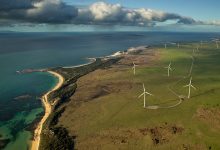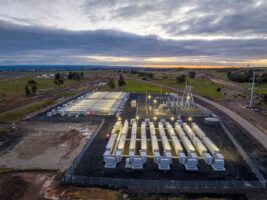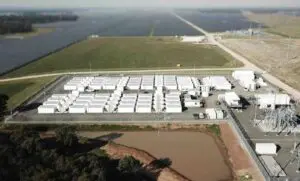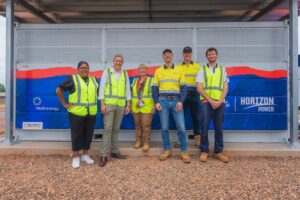A new report commissioned by the Bob Brown Foundation has questioned the viability of Tasmania’s multi-billion dollar “Battery of the Nation” project, saying that it is unlikely that Victoria will actually need its “deep storage” and warning that Tasmanians could be saddled with massive costs.
The Battery of the Nation project is being promoted by the state government and its utilities as a “state-building” project: It will involve at least two new sub-sea links to Victoria, the Marinus Links, new pumped hydro facilities, more wind farms and transmissions lines. It is the basis for the Liberal state government’s target of “200 per cent renewables” by 2040.
But the Bob Brown Foundation – and former Green leaders Brown and Christine Milne – question whether it is the right thing to do, and they commissioned Bruce Mountain and Steve Percy from the Victoria Energy Policy Centre to do an analysis. And it suggests that the project is not viable.
Tasmania has argued that its plans are needed to provide “deep storage” to fill in the days or weeks when what will be Victoria’s renewable dominated grid finds itself short of wind and solar power, particularly in winter. Listen to our Energy Insiders podcast with Hydro Tasmania CEO Steve Davy. AEMO has identified the Marinus project as one of several keys to its transition plans to a high renewable grid, but that is possibly because they see it as a fait accompli.
The VEPC report, however, finds there might be money to be made from short-term storage, but not much in long term storage.”The incremental gains from buying electricity when it is cheap and selling it when it is expensive, taper off quickly when storage duration exceeds four hours,” it says. And its analysis of AEMO data suggests that deep storage longer than four hours from Tasmania will be rarely needed.
It says battery storage built in Victoria might be a better option. Matching the 1,500MW capacity of the Marinus Link with four-hour batteries could be done at less than half the cost. The same capacity of six-hour batteries could be provided for 79 per cent of the cost, and 1,500MW of eight hour battery storage was still cheaper.
“In other words, even if Hydro Tasmania could provide 1,500 MW of hydro and pumped storage without incurring any additional cost, it will still be cheaper to build 1,500 MW of batteries in Victoria rather than to build Marinus Link,” the paper concluded. But it also notes that the total cost of the Battery of the Nation project, including pumped hydro, could be $7.1 billion.
“The implication of this analysis is that mainland Australia does not need Marinus Link and Battery of the Nation to transition to 100% renewable energy,” the report concludes. “Much cheaper options are available to achieve the transition.”
It also questions if Victorian electricity consumers can reasonably be expected to contribute to the cost of Marinus Link. If not, it is unlikely that Tasmania consumers could afford to bear the cost.
“Though the main purpose of Marinus Link is to provide dispatchable capacity to Victoria, batteries would be much cheaper and would be provided in the contestable wholesale market and so would not impose mandated charges on consumers, as Marinus Link will.
“It is therefore inevitable that the development of Marinus Link will significantly raises electricity prices in Tasmania, mainly through the regulated recovery of the costs of Marinus Link, which will almost triple the value ofTasNetworks’ regulatory asset base.”
Mountain and his team – along with many other energy experts it should be said – have also been highly critical of the massive Snowy 2.0 pumped hydro scheme being built by the federal government owned utility Snowy Hydro.
They say it risks being a white elephant, because it will also be rarely used, and the question of who will pay for the huge transmission needs is not settled.
Snowy Hydro has argued that renewable energy generators should pay for their own transmission costs, but it doesn’t want to stump up for the multi-billion solar costs for its own project. And the push for more transmission lines, while critically needed in some circumstances, is an issue that will surely be subject of intense debate in the years to come.
Mountain and Percy note that if the Marinus Link does not go ahead, then there will be little point in building many more wind farms in Tasmania, despite its superior wind resource.
“The cost advantages of the superior wind resources in Tasmania do not come close to recovering the much higher cost of transmitting electricity from Tasmania to Victoria,” the report says.
“Furthermore, technology development, particularly in harvesting less consistent and weaker winds, through ever large blades, suggests that the advantage that Tasmania currently enjoys through its more consistent and stronger winds will diminish in future.”
That would be bad news for developers such as UPC, which wants to build massive wind farms on Robbins Island and Jim’s Plain, but whose transmission plans have been the subject of much debate.
Brown has also questioned some of the wind farm proposals in the north west of Tasmania, including Robbins Island, saying the proposal could harm critically endangered birds and affect landscape’s natural beauty.
Milne says the report was commissioned to test the assumptions that the mainland needs Tasmania renewable energy and that the new interconnected across Bass Strait would be economically available.
“This report demonstrates that it won’t be, and nor is it necessary to address the climate crisis,” Milne told RenewEconomy. “Why would you waste taxpayers’ money on a project that is not necessary or viable.
“People say this will enable renewable energy, so it must be a good project. But we already have energy security in Tasmania and the mainland does not need this to transition to 100% renewables. It will divert $7.1 billion from other technologies and investments that would be far more useful (to cutting emissions).”










